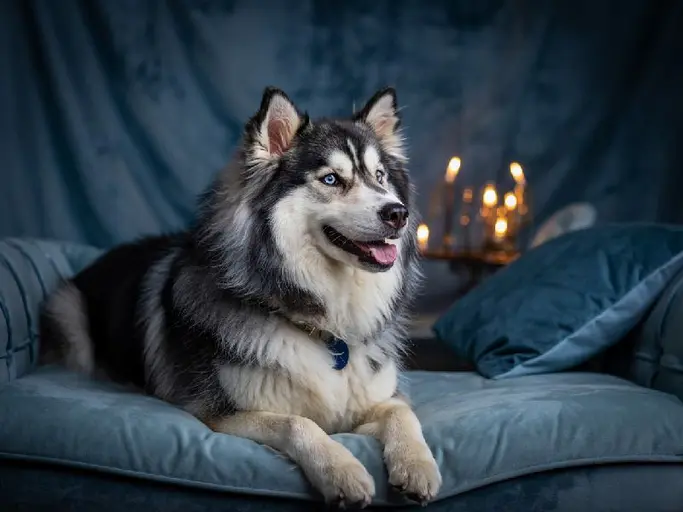The Siberian Husky: A Comprehensive Guide to This Energetic Breed

Brief Introduction: The Siberian Husky
The Siberian Husky is a medium-sized working dog breed. Instantly recognizable by their striking appearance, often featuring piercing blue eyes and a thick double coat, Huskies are known for their incredible endurance and friendly disposition. Originating from the harsh landscapes of Siberia, these dogs were bred for pulling sleds over long distances, showcasing their strength and resilience. What makes them attractive to many is their intelligent, independent nature coupled with their playful and affectionate side. They are not typically guard dogs, preferring to greet strangers with a friendly wag of the tail.
The History of the Breed
Origins in Siberia
The story of the Siberian Husky begins with the Chukchi people, a nomadic tribe from northeastern Siberia. For centuries, they relied on these dogs to transport people and goods across the frozen tundra. These early Huskies were not just working animals; they were integral members of the family, sharing the Chukchi’s lives and even sleeping in their homes for warmth. Their survival and that of the Chukchi were intertwined.
Evolution and Purpose
The Chukchi meticulously bred these dogs for speed, endurance, and a gentle temperament. Their ability to pull light loads over vast distances with minimal food was essential. This careful selection process shaped the breed’s physical and mental characteristics. Unlike many other sled dog breeds focused on brute strength, the Siberian Husky was developed for efficiency and stamina.
Arrival in North America
The Siberian Husky’s journey to North America began in the early 20th century. They were introduced to Alaska as racing sled dogs, quickly proving their worth in grueling races like the All-Alaska Sweepstakes. Their lighter build and remarkable endurance allowed them to outperform many other sled dog breeds.
The Serum Run Hero
Perhaps the most famous event in the Siberian Husky’s history is their role in the 1925 serum run to Nome, Alaska. A diphtheria epidemic threatened the town, and a team of mushers and their Huskies relayed a life-saving antitoxin serum across hundreds of miles of treacherous terrain. Balto, a Siberian Husky, became a national hero for leading his team through the final leg of the journey. This event cemented the breed’s reputation for courage, resilience, and unwavering dedication.
Appearance: Striking and Efficient
Size and Build
Siberian Huskies are medium-sized, athletic dogs. Males typically stand between 21 and 23.5 inches tall at the shoulder and weigh between 45 and 60 pounds. Females are slightly smaller, ranging from 20 to 22 inches in height and weighing between 35 and 50 pounds. Their bodies are well-proportioned, with a deep chest and a strong, muscular build that hints at their working heritage.
Coat and Color
The Siberian Husky’s most distinctive feature is their thick, double coat. This coat provides excellent insulation against extreme cold, but also helps to regulate body temperature in warmer weather. The outer coat is medium in length and straight, while the undercoat is soft and dense. Huskies come in a wide variety of colors, including black and white, gray and white, red and white, and pure white. Many have distinctive markings, such as masks or caps.
Head and Facial Features
The Siberian Husky’s head is wedge-shaped, with a medium-length muzzle. Their ears are triangular, erect, and set high on the head. Their eyes are almond-shaped and can be brown, blue, or sometimes one of each (heterochromia). The piercing gaze of the Siberian Husky is often considered one of their most captivating traits.
Tail
The Siberian Husky’s tail is well-furred and brush-like. It is typically carried in a graceful curve over the back, resembling a sickle. When the dog is relaxed, the tail may hang down. The tail is a vital part of the Husky’s thermoregulation system, providing warmth when wrapped around the nose and face.
Character and Behavior
Temperament Towards People
Siberian Huskies are known for their friendly and outgoing personalities. They are typically good-natured and affectionate towards people, including strangers. They are not naturally protective or territorial, so they don’t usually make good guard dogs. Their enthusiasm for life is infectious, and they often greet new acquaintances with excitement and playful energy.
Attitude Towards Children
Huskies are generally good with children, making them suitable family pets. Their playful nature and high energy levels mean they enjoy playing games and engaging in activities with kids. However, like all dogs, they should be supervised around young children to ensure that interactions are safe and respectful. Teaching children how to interact properly with dogs is crucial.
Relationships with Other Animals
The Siberian Husky’s strong prey drive can sometimes pose challenges in homes with smaller animals, such as cats, rabbits, or rodents. While some Huskies can learn to coexist peacefully with other pets, careful introductions and supervision are essential. Early socialization and training can help to mitigate these instincts. Introducing a husky puppy to a cat, for example, may be easier than introducing an adult husky.
Activity Level and Exercise Needs
Siberian Huskies are high-energy dogs that require a significant amount of exercise. They were bred to run and pull, so they need plenty of opportunities to burn off their energy. Daily walks, runs, hikes, and playtime are essential for their physical and mental well-being. Without adequate exercise, Huskies can become bored, destructive, and prone to behavioral problems.
Trainability: A Challenge and Reward
Siberian Huskies are intelligent but independent dogs. They are not always eager to please and can be stubborn during training. Positive reinforcement methods, such as treats, praise, and play, are most effective. Consistency and patience are key when training a Husky. Early socialization and obedience training are crucial to establish good manners and prevent behavioral issues. They need a strong leader and a consistent routine for maximum success.
Breed Characteristics: Independent and Vocal
Siberian Huskies are known for their distinctive vocalizations, including howls, barks, and yips. They are not excessive barkers, but they will often “talk” to their owners or other dogs. They are also prone to escaping, due to their independent nature and high energy levels. Secure fencing is essential to prevent them from roaming. They are also very intelligent and can open doors, gates and even dig under fences.
![Siberian Husky: Character, Care & History | [Your Clinic Name]](/media/2025/04/opieka-siberian-husky.webp)
Care and Maintenance
Grooming Essentials
Siberian Huskies have a double coat that requires regular grooming. They shed moderately throughout the year and heavily during shedding season (usually twice a year). Brushing them several times a week can help to remove loose hair and prevent matting. During shedding season, daily brushing may be necessary. Bathing is only needed occasionally, as excessive bathing can strip the coat of its natural oils. No need for the Husky to be trimmed unless medically advised by a veterinarian.
Exercise Requirements
As mentioned earlier, Siberian Huskies require a significant amount of exercise. Aim for at least two hours of exercise per day, including walks, runs, and playtime. They enjoy activities such as sledding, skijoring, and agility training. Provide plenty of opportunities for them to run and explore in a safe and controlled environment.
Diet and Nutrition
Siberian Huskies should be fed a high-quality dog food that is appropriate for their age, size, and activity level. Avoid overfeeding, as they can be prone to weight gain. Consult with your veterinarian to determine the appropriate portion sizes and feeding schedule. Always provide fresh, clean water.
Health Considerations
Siberian Huskies are generally healthy dogs, but they are prone to certain health conditions, including:
- Hip dysplasia
- Progressive retinal atrophy (PRA)
- Cataracts
- Corneal dystrophy
Regular veterinary checkups are essential to monitor their health and detect any potential problems early on. Responsible breeders screen their breeding dogs for these conditions to minimize the risk of them being passed on to puppies.
Breed Weaknesses
Aggression Levels
Siberian Huskies are not typically aggressive dogs towards humans. However, their strong prey drive can make them unsuitable for homes with small animals. Early socialization and training can help to minimize this risk. Aggression towards other dogs can also occur, especially between dogs of the same sex.
Loyalty and Independence
While Siberian Huskies are affectionate with their families, they are not always as intensely loyal as some other breeds. Their independent nature can make them less eager to please and more prone to wandering. Secure fencing and consistent training are essential to keep them safe.
Specific Weaknesses
- High energy levels require a significant commitment to exercise.
- Strong prey drive can be a challenge in multi-pet households.
- Independent nature can make training difficult.
- Prone to escaping and roaming.
- Heavy shedding requires regular grooming.
Conclusion: Is the Siberian Husky Right for You?
The Siberian Husky is a magnificent breed that requires a dedicated and active owner. They are best suited for people who can provide them with plenty of exercise, consistent training, and a secure environment. If you are looking for a friendly, energetic, and independent companion, the Siberian Husky may be the perfect breed for you. However, be prepared to commit to their specific needs and challenges. If you enjoy outdoor activities and can provide the leadership and structure that a husky needs, you’ll surely enjoy the companionship of this amazing breed!
Frequently Asked Questions About Siberian Husky
-
Are Siberian Huskies good family dogs?
Yes, Siberian Huskies are generally good with children and can make suitable family pets. They are playful and energetic, enjoying games and activities with kids, but supervision is recommended with younger children.
-
How much exercise do Siberian Huskies need?
Siberian Huskies are high-energy dogs that require a significant amount of exercise, ideally at least two hours per day. This can include walks, runs, hikes, and playtime. They thrive on activities like sledding and agility training.
-
Do Siberian Huskies get along with other pets?
Siberian Huskies have a strong prey drive, which can pose challenges in homes with smaller animals like cats, rabbits, or rodents. Careful introductions and supervision are essential. Early socialization and training can help mitigate these instincts.
-
Are Siberian Huskies easy to train?
Siberian Huskies are intelligent but independent dogs, which can make training challenging. They are not always eager to please and can be stubborn. Positive reinforcement methods, consistency, and early socialization are crucial for success.
-
How much do Siberian Huskies shed?
Siberian Huskies have a double coat that requires regular grooming. They shed moderately throughout the year and heavily during shedding season (usually twice a year). Regular brushing is essential to remove loose hair and prevent matting.
-
Are Siberian Huskies prone to any health problems?
Siberian Huskies are generally healthy dogs, but they are prone to certain health conditions, including hip dysplasia, progressive retinal atrophy (PRA), cataracts, and corneal dystrophy. Regular vet checkups are essential.
-
Are Siberian Huskies good guard dogs?
No, Siberian Huskies are not typically guard dogs. They are friendly and outgoing, preferring to greet strangers with a friendly wag of the tail rather than showing protective or territorial behavior.
-
Do Siberian Huskies need a lot of space?
While they don’t necessarily need a huge yard, Siberian Huskies need ample opportunities for exercise. A secure yard is important, as they are prone to escaping. Regular walks, runs, and playtime are essential to keep them happy and healthy.
-
What is the typical temperament of a Siberian Husky?
Siberian Huskies are known for their friendly and outgoing personalities. They are typically good-natured and affectionate towards people, including strangers. They are energetic, playful, and enthusiastic about life.
-
Are Siberian Huskies prone to aggression?
Siberian Huskies are not typically aggressive towards humans. However, their strong prey drive can make them unsuitable for homes with small animals. Aggression towards other dogs can occur, especially between dogs of the same sex, highlighting the need for careful socialization.

